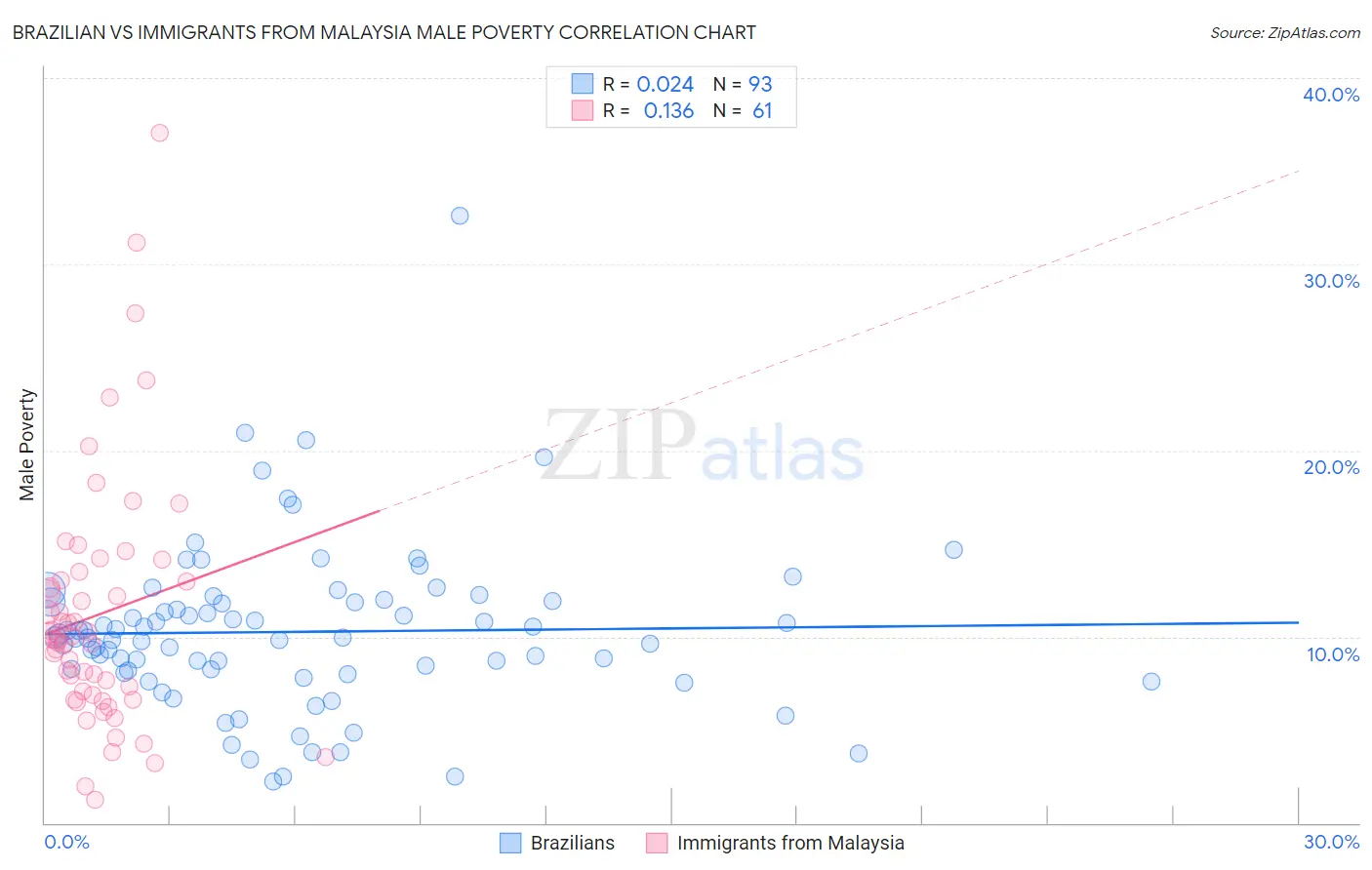Brazilian vs Immigrants from Malaysia Male Poverty
COMPARE
Brazilian
Immigrants from Malaysia
Male Poverty
Male Poverty Comparison
Brazilians
Immigrants from Malaysia
10.8%
MALE POVERTY
82.7/ 100
METRIC RATING
135th/ 347
METRIC RANK
11.0%
MALE POVERTY
64.7/ 100
METRIC RATING
155th/ 347
METRIC RANK
Brazilian vs Immigrants from Malaysia Male Poverty Correlation Chart
The statistical analysis conducted on geographies consisting of 323,645,938 people shows no correlation between the proportion of Brazilians and poverty level among males in the United States with a correlation coefficient (R) of 0.024 and weighted average of 10.8%. Similarly, the statistical analysis conducted on geographies consisting of 197,921,131 people shows a poor positive correlation between the proportion of Immigrants from Malaysia and poverty level among males in the United States with a correlation coefficient (R) of 0.136 and weighted average of 11.0%, a difference of 2.4%.

Male Poverty Correlation Summary
| Measurement | Brazilian | Immigrants from Malaysia |
| Minimum | 2.2% | 1.3% |
| Maximum | 32.6% | 37.1% |
| Range | 30.4% | 35.8% |
| Mean | 10.3% | 11.2% |
| Median | 10.0% | 9.9% |
| Interquartile 25% (IQ1) | 8.1% | 6.8% |
| Interquartile 75% (IQ3) | 11.9% | 13.2% |
| Interquartile Range (IQR) | 3.8% | 6.5% |
| Standard Deviation (Sample) | 4.4% | 6.7% |
| Standard Deviation (Population) | 4.4% | 6.6% |
Demographics Similar to Brazilians and Immigrants from Malaysia by Male Poverty
In terms of male poverty, the demographic groups most similar to Brazilians are Immigrants from Israel (10.8%, a difference of 0.31%), Immigrants from Switzerland (10.8%, a difference of 0.57%), Yugoslavian (10.8%, a difference of 0.72%), Immigrants from Jordan (10.8%, a difference of 0.84%), and Tlingit-Haida (10.9%, a difference of 1.0%). Similarly, the demographic groups most similar to Immigrants from Malaysia are Immigrants from Kazakhstan (11.0%, a difference of 0.010%), Immigrants from Bosnia and Herzegovina (11.0%, a difference of 0.050%), Venezuelan (11.0%, a difference of 0.29%), Immigrants from Nepal (11.0%, a difference of 0.29%), and Guamanian/Chamorro (11.0%, a difference of 0.32%).
| Demographics | Rating | Rank | Male Poverty |
| Brazilians | 82.7 /100 | #135 | Excellent 10.8% |
| Immigrants | Israel | 80.9 /100 | #136 | Excellent 10.8% |
| Immigrants | Switzerland | 79.2 /100 | #137 | Good 10.8% |
| Yugoslavians | 78.2 /100 | #138 | Good 10.8% |
| Immigrants | Jordan | 77.5 /100 | #139 | Good 10.8% |
| Tlingit-Haida | 76.1 /100 | #140 | Good 10.9% |
| Immigrants | France | 75.8 /100 | #141 | Good 10.9% |
| Basques | 74.6 /100 | #142 | Good 10.9% |
| Afghans | 71.9 /100 | #143 | Good 10.9% |
| Samoans | 71.8 /100 | #144 | Good 10.9% |
| Immigrants | Germany | 71.6 /100 | #145 | Good 10.9% |
| Syrians | 71.4 /100 | #146 | Good 10.9% |
| Icelanders | 68.5 /100 | #147 | Good 11.0% |
| Armenians | 68.0 /100 | #148 | Good 11.0% |
| Immigrants | Venezuela | 67.9 /100 | #149 | Good 11.0% |
| Guamanians/Chamorros | 67.6 /100 | #150 | Good 11.0% |
| Venezuelans | 67.4 /100 | #151 | Good 11.0% |
| Immigrants | Nepal | 67.3 /100 | #152 | Good 11.0% |
| Immigrants | Bosnia and Herzegovina | 65.2 /100 | #153 | Good 11.0% |
| Immigrants | Kazakhstan | 64.8 /100 | #154 | Good 11.0% |
| Immigrants | Malaysia | 64.7 /100 | #155 | Good 11.0% |